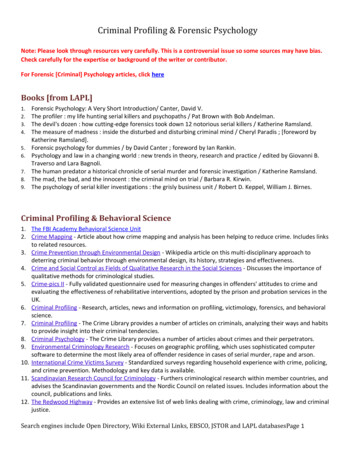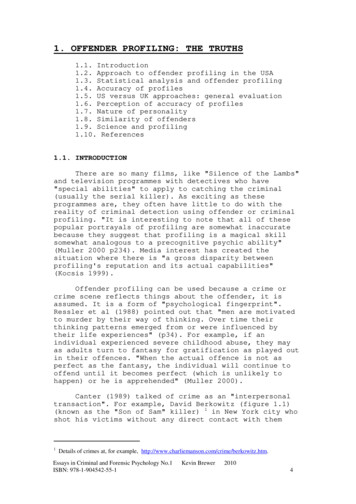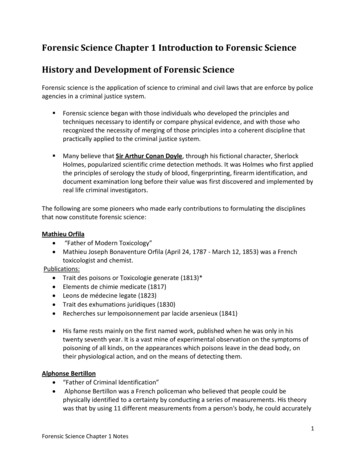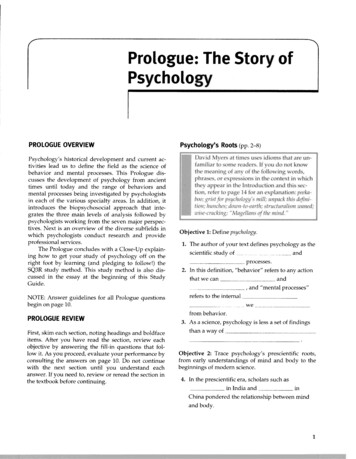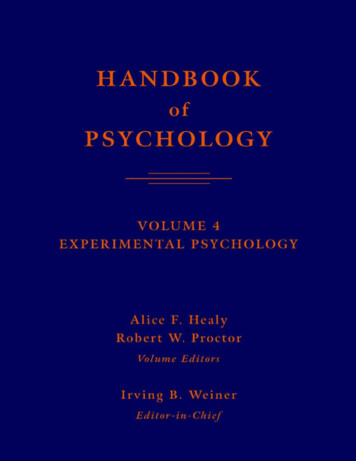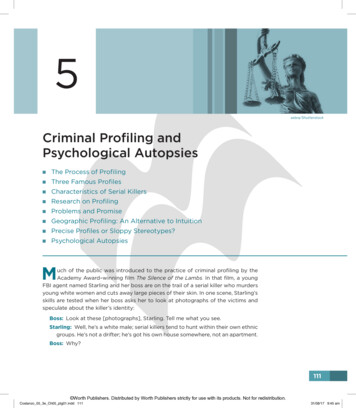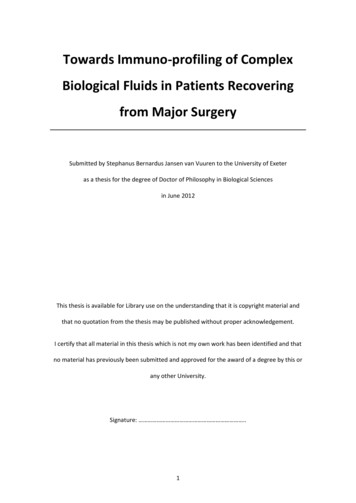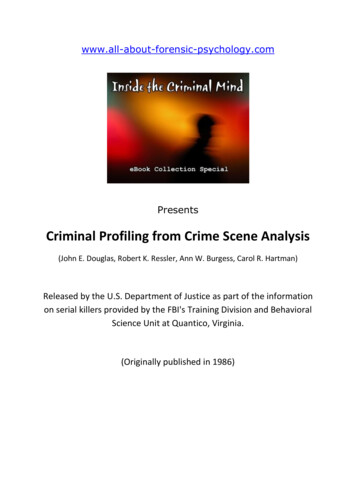
Transcription
Forensic Psychology andProfiling
We have culture that is obsessed withcriminals and those who catch them:
Definition of Murder Types In the past thirty years, multiple definitions ofserial murder have been used by law enforcement,clinicians, academia, and researchers. While thesedefinitions do share several common themes, theydiffer on specific requirements, such as:– the number of murders involved,– the types of motivation,– the timing aspects of the murders. Most of the definitions also required a period oftime between the murders. This “Cooling-OffTime” was necessary to distinguish between amass murder and a serial murder.
Mass Murder Generally described as a number of murders (four or more)occurring during the same incident, with no distinctivetime period between the murders. These events typicallyinvolved a single location, where the killer murdered anumber of victims in an ongoing incident.
Spree MurderThe general definition is twoor more murders committedby an offender or offenders,without a cooling-off period. The factors included in thedefinition of serial murderinclude:– One or more offenders.– Two or more murderedvictims– Incidents should be occurringin separate events, atdifferent times, but with shortintervals between.
Serial Murder The unlawful killing of two or more victimsby the same offender(s), in separate eventswith a cool down period.
There are a few more common terms thatyou need to learn before we can really getstarted on this subject. So lets review thevocabulary:7
Corpus delicti Latin for "body of crime"; a term from Westernjurisprudence referring to the principle that a crime musthave been proven to have occurred before a person can beconvicted of committing that crime. For example, a person cannot be tried for larceny unless itcan first be proven that property has been stolen. Black's Law Dictionary (6th ed.) defines it as: "the fact ofa crime having been actually committed."
Modus Operandi – the operating technique used by theoffender. The actions necessary to committhe crime.9
Signature – Is often referred to asthe “calling card” ofthe offender. Theperson goes beyondwhat is necessary tocommit the crime, i.e.stab a specific numberof times.10
Staging – Altering the crime scene to throw theinvestigation, this may happen withorganized offenders.11
Undoing – Usually takes place when there is a closerelationship between the victim andoffender.– A defence mechanism in which a person tries to 'undo'an unhealthy, destructive or threatening thought oraction by engaging in contrary behavior. For example,peacefully displaying a murder victim after death tolook like they are sleeping.12
Concept of Escalation The concept of escalation involves anincrease in the intensity of criminalbehavior. Crimes start at a minor leveland progress to worsening levels.– Burglary is often correlated later withmurder.13
Investigative Psychology: Is the application of psychology to criminalinvestigations.
Profiling: One of the tasks oftenassociated withinvestigative psychology.– Requires sketchingthe significantpsychological anddemographicfeatures of aperson or persons.
Investigative Psychology Broadly defined, investigative psychologyincludes research and practice involving:––––––ProfilingRisk AssessmentPolice Line-upsInterrogationPolygraphHypnosis
Criminal Profiling is: The process ofidentifying:– personality traits,– behavioral tendencies,– geographical location,– Demographic/biographicdescriptors of offenders based on crime scenecharacteristics.
3 Questions asked byProfilers
What are the important behavioral features ofthe crime that may help identify andsuccessfully prosecute the perpetrator?
What inferences can be made about thecharacteristics of the offender that may helpidentify him or her?
Are there any other crimes that are likely tohave been committed by the same person? (Geographic Profiling)
Criminal Profiling Overview:
Goals of Profiling The primary goal ofprofiling is to narrow thefield of possible suspects. Profiling is also a form ofprediction -- the profilertries to “predict” who theoffender or offenders mightbe and where and how thenext crime may occur.
Example of the final stage in profiling
Why Use Criminal Profiles inLaw Enforcement? Traditional investigative techniques often fall shortin extreme cases. Certain subsets of offenses/offenders areconsidered most suitable for profiling.
What crimes are more suitable forprofiling? Sadistic sexual assaultsSexual homicidePostmortem cases of abuse and humiliationMotiveless fire settingsLust and mutilation murdersRapeOccult and ritualistic crimesChild sexual abuse including pedophiliaBank robberiesAnonymous obscene communications
The Nitty Gritty of
Assumptions Made (About a singlesubject) in the Profiling Process:All of the following must be true in order forprofiling to be at all possible.1.2.3.4.Crime scene reflects the personality of the offender.M.O. remains similar in all of their crimes.Signature will remain the same in all of their crimes.Offender’s personality will not change over the courseof time they are committing the crimes.
The Organized-Disorganized TypologyThe FBI Model Whether the crimescene is leftORGANIZED orDISORGANIZED issaid to provideinformation aboutthe offender’scriminalsophistication andpersonality.
An Organized crime scene reflects: An offender who commits crime out of aneed for power. Motivation associated withPSYCHOPATHY.
The Organized Crime Scene Offense plannedVictim a targeted strangerVictim personalizedControlled conversationCrime scene reflectsoverall control Demands submissivevictim Restraints used Aggressive acts prior todeath Body hidden Weapon/evidence absent victim or bodytransported from scene Associated withpsychopathy
A Disorganized crime scene reflects: An offender who commits crime out ofpassion, compulsion, frustration, or anxiety. Motivation associated with PSYCHOSIS.
The Disorganized Crime Scene Spontaneous offenseVictim or location knownDepersonalizes victimMinimal conversationCrime scene random andsloppy Sudden violence to victim Minimal use of restraintsSexual acts after deathBody left in viewEvidence/weapon oftenpresent Body left at death scene Associated with Psychosis
Organized Killers: Dexter Ted Bundy BTK Jeffery Dahmer
Disorganized Killers: Ed Gein “Son of Sam” DavidBerkowitz
Classification of OffendersORGANIZEDDISORGANIZEDVICTIMSWives and girlfriends safe –gets more pleasure fromkilling than sex with wivesand girlfriends – SingleWhite Female.Anybody – very poorrelations with women ingeneral. Usually live alone.CRIME SCENECrime scene staged, andtransport bodyNo staging, leave bodywhere killed.WEAPONMay carry weapon with him,and take them away after thecrime, i.e. rape kitsUses weapon ofopportunity, frenzied attack,often depersonalizes thevictim, i.e. turn them ontheir stomachs36
Classification of r at school.Classmates won’tremember the offender.PERSONALITYExternalize anger, oftenattractive, confident,intelligent, good verbalskills. History ofproblems with authority.Internalize anger,physically unattractive,low self-esteem, andprevious suicide attempts,not very articulate inconversation.RELATIONSHIPS WITHWOMENTalks to women, mood isfairly controlled.Doesn’t often talk towomen, mood is anxious37
Classification of OffendersORGANIZEDDISORGANIZEDPLACE OFRESIDENCELive some distance from thecrime, except the first crime,as it is close to home and morecomfortable. Usually livewith a woman.Kills where there isfamiliarity, usually close tohome or to work. Livesalone.PRE-OFFENCEMay be precipitated by loss ofjob or break-up with partner.Low self-esteem comes onvictim of opportunity.PUBLICITYTakes interest in media reportsof crime, will often try to getinvolved with the policeinvestigationNo interest in / fear of mediareports of crime.38
Hamilton Howard "Albert" Fish(May 19, 1870 – January 16, 1936) Also known as the Gray Man,Werewolf of Wysteria, BrooklynVampire, Moon Maniac and TheBoogey Man.He was a child rapist & cannibal.Suspect in at least five murders duringhis lifetime.Confessed to three murders that policewere able to trace to known homicides.Tried for the kidnapping and murder ofGrace Budd, and was convicted andexecuted by electric chair.
Profile Versus the Truth:J.B. Helfgott
Distinction BetweenPsychopathy and Psychosis PSYCHOPATHY– Personality disorder made up of a particular constellation ofcharacteristics).– Lack of attachment, defect in affect, absence of anxiety.– In touch with reality.– Severe Lack or Empathy. PSYCHOSIS– Clinical mental illness – Schizophrenia.– May meet legal definition of insanity.– Out of touch with reality.
Geographical Profiling andMapping Geographical profiling refers tothe analysis of geographicallocations associated with thespatial movements of a singleserial offender. Geographical mapping isconcerned with analyzing thespatial patterns of crimescommitted by numerous offendersover a period of time.Geographical mapping focuses onidentifying the “hot spots” ofcertain types of crime.
Example of Geographic Profiling
Current Approaches to Offender Profiling:American Approach: Incarcerated serial murderers(36) interviewed. Categorised into organised ordisorganised. View crime scene forindicators.
American FBI Approach: Basis is:– Crime scene and MO as indicators ofindividual pathology.– Compare with known offenders.– May fit pattern.– Can be used to detect, but also to predict andtherefore prevent.
American FBI Approach: Aims of American profiling approachare:– Reduce scope of investigation.– Allow some prediction of future offences.– Provide a psychological evaluation ofbelongings found in the murdererspossession, e.g. souvenirs from previousoffences.– Provide strategies for interviewing.
British Approach British approach is less subjective. Called “bottom up” method, or“data-driven”. Data is collected and analysed toproduce definite, measured, specificassociations between offences andoffender characteristics.
British Approach Dominated by DavidCanter Made his name withthe “Railway Rapist”in 1985
David Canter Traditionally, the only valuable clues at acrime scene were hard evidence, e.g.– blood,– semen– Fingerprints– Hair– etc.
David CanterProfiling proposes that there are also less recognisedclues which also define the offender. The problemis to interpret these clues correctly. the choice of victim,the location,the nature of the assault,what is and isn't left behind,what is and isn't said to the victim,whether or not the victim is killed
David Canter Over a period of four years, a series of sexual assaults andrapes, culminating in the murder of three women, hadbeen committed in the London area. The police had linked all these crimes to the same manbut, despite extensive inquiries, had failed to make anarrest. Canter went through each case in detail, looking at thelocation, time of day, and the nature of the victim. He then drew up a profile of the likely suspect, includingwhere he was likely to be living.
Information Collected: North London: Kilburn Area. 3 Murders and 26 Rapes . 1982 and 1986. Victims: Women, Early 20’s, Strangers. Attacked During Night. On or Near Railway. Used Mask & Conversation. Violent Rapes. Used a Knife. Talked to victim after rape. Questioned victims about where they lived. Varied Description of Rapist by victims. Greeted victims as he passed and thenattacked from behind. Restrained victims by fastening hands behindtheir backs. Gave victims instructions on how to get home.
Some of Canter’s Profile Details:Home Location Livedin middle of crimesMarital Status Married,Friendships OnlyExtracurricular activities Martial ArtsPrevious Actions Toward Women Violencetowards wifePornography Interest? Collectorof hard-core pornOccupation Carpenterwith British RailAge 28no kids, later separatedtwo male friendswhen arrested (Started age 24)
As a result of this profile,the police were able tofocus their investigation onJohn Duffy, a man who hadpreviously ranked nohigher than 1,505th on thelist of possible suspectsand, within a comparativelyshort period of time, hadgathered enough evidenceto convict.
How often is profiling used? There are less than 100 full time profilersin USA and the U.K. The FBI produces 1000 profiles/year inUSA. There were 242 profiles produced between1981-1995 U.K.
Law Enforcement SatisfactionEvaluation studies, police say: 83% – of the time it is “operationally useful.” 69% – of them would definitely use profilingagain.But only 2.7% said profiling helped identify offender.14% said it helped solve their case.16% said it opened new lines of inquiry.
Profile Content Analysis CategoriesThe statements made in 21 different criminal profiles were analyzed byplacing them in one of the categories below (done by a group ofpeople who evaluated the effectiveness of criminal profiles): Factual/Summary information – case infoUnsubstantiated opinion (e.g., no backing)Unverifiable (e.g., emotions)Ambiguous (e.g., vague – “poor skills”)Opposing alternatives – multiple outs
Results of Content This Analysis 3090 statements total from the 21 profiles(Mean 147/profile) Only 25% statements were predictionsabout offender (780 total) 82% – unsubstantiated 55% – unverifiable 24% – ambiguous 6% – opposing alternatives 1% – fully justified (most from 1 profile)
The Process
National Center for the Analysis of ViolentCrime The NCAVC is a componentof the FBI’s Critical IncidentResponse Group (CIRG),located in Quantico, Virginia.Its primary mission is toprovide behaviorally-based,operational support to federal,state, local, and inter
Forensic Psychology and Profiling. We have culture that is obsessed with criminals and those who catch them: In the past thirty years, multiple definitions of serial murder have been used by law enforcement, clinicians, academia, and researchers. While these definitions do share several common themes, they differ on specific requirements, such as: – the number of murders involved, –the .
